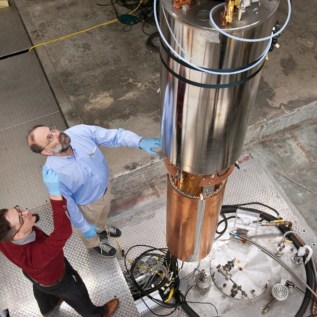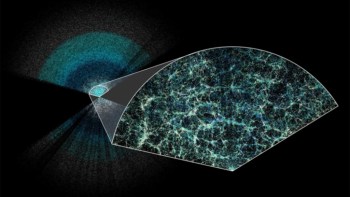
By Hamish Johnston
There’s an interesting preprint on the arXiv server that proposes a new way of detecting dark-matter particles. I’ve been thinking about dark matter because last week physicists working on the LUX experiment announced that the underground detector had failed to find any dark-matter particles in the first three months of its operation. LUX was designed to look for WIMPs (weakly interacting massive particles), but WIMPs are not the only game in town when it comes to dark matter. There are also axions, which are the quarry of this latest proposal by three physicists in the US.
Axions are hypothetical particles that were first postulated in the 1970s to help explain puzzling aspects of quantum chromodynamics, which is the theory that describes interactions between quarks and gluons. Axions are also interesting from a cosmological point of view because they have mass but do not interact strongly with electromagnetic radiation. These properties make them prime candidates for dark matter, a mysterious substance that appears to make up most of the matter in the universe.
Much like WIMPs, physicists have tried repeatedly to make direct measurements of axions but have found nothing so far. The ADMX axion experiment at the University of Washington (pictured above) is an example of a cutting-edge axion search.
Now, David Tanner, Pierre Sikivie and Neil Sullivan of the University of Florida in Gainesville have come up with a new way of looking for axions – which they describe in a preprint entitled “Axion dark matter detection using an LC circuit“.
The proposed detector is based on the idea that when axions are in the presence of a strong magnetic field they can transform into photons. Such transitions would create an oscillating electric current, which in turn would produce a tiny magnetic field.
It is this magnetic field that the Florida physicists plan to look for using a simple electrical circuit and a SQUID magnetometer. The circuit comprises a capacitor and inductor (magnetic coil) and a “pick-up loop” that would monitor the magnetic field inside a superconducting magnet. The SQUID and inductor would be located some distance from the magnet and the SQUID would detect tiny fluctuations in the magnetic field produced by the inductor coil. These fluctuations could be related back to the tiny magnetic fields created by axions inside the magnet.
The trio says that the set-up is compatible with existing magnets such as those used in the CMS detector at CERN and ADMX, as well as the proposed International Axion Observatory (IAXO).
I asked Tanner whether the team plans to build a prototype detector and he replied: “We are planning to set up a small-scale or pilot experiment.” He said that such an experiment would allow the team to gain important information about the technical challenges involved in creating a practical experiment. These include overcoming problems such as flux noise and mechanical vibrations, as well as learning how to tune the resonator and the Q values that can be achieved.
If all goes well, Tanner says a detector could be used in conjunction with the ADMX or IAXO magnets.



